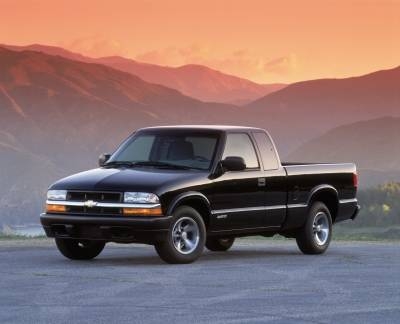
The Chevrolet S-10 pickup truck was built from 1982-2004 with a variety of power plants, including the 2.5- and 2.2-liter four-cylinder engines and the 2.8- and 4.3-liter V6 engines. Most of these engines can benefit from simple bolt-on parts that increase performance. The average backyard mechanic can maximize performance on an S-10 in about two hours.
Install high-performance spark plugs by uncapping their wires and turning them in a counterclockwise direction, then replacing the plug with a new one and turning it clockwise into the empty plug hole. The need to gap the tip of the plug is only relevant if the plug is an older-style, single-node type. Multifire plugs, with multiple nodes on the tips, cannot be easily gapped. Heat ranges vary, but the S-10 with a 4.3 V6 calls for a heat range of 4, and going to a class 5 plug will boost horsepower.
Increase the width of the ignition wires by replacing them with 8 mm types (the wires pull off with minimal tugging). The wider wire will cause less resistance for the energy being sent to the plugs, and replacing the worn-out plug wires with a new version will increase performance. Stock width for the later S-10 models was 7 mm, and earlier versions could have 6 mm wires. Wires also can be purchased in a variety of colors.
Add an air snorkel with an open element filter by removing the air box and intake hose and mounting the snorkel into the same area. The air box has two screws holding it in, and the hose will come with it, but be sure to disconnect the MAF sensor on the air hose, if so equipped. The open element will allow more air into the intake and allow the engine to "breathe" easier. More, colder air will deliver more horsepower because the oxygen molecules are closer together than with warm air. The engine can gulp as much as it requires without straining or "bogging down" like it would with an air box.
Clean the intake and intake manifold with a can of spray carburetor cleaner. Most types of cleaner are made for both fuel-injected and carburetor-style fuel delivery systems, so the only real difference is packaging. Spray a liberal amount of cleaner onto and into the intake manifold with the air hose removed and the engine off. Let it sit for a few minutes, then spray it down again. Once the cleaner has dried, crank the motor and give short bursts of cleaner to the intake while tugging on the throttle cable to keep the RPM's up. The cleaner will stall the motor, so giving a little gas will keep it alive for the cleaning. Shut the motor off and allow the intake to dry.